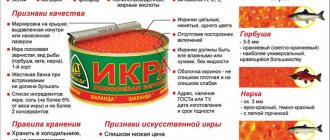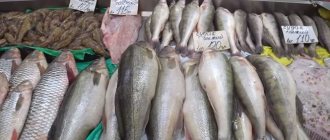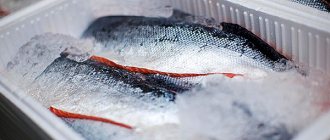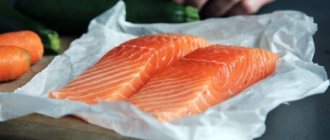Salmon is different from salmon
The largest volume, both in terms of catch and consumption, is accounted for by pink salmon caviar, which is about 80% of the red caviar sold in our country; the remaining 20% is divided between sockeye salmon, chum salmon, coho salmon and chinook salmon. Moreover, very little Chinook caviar is sold, since this type of salmon is quite rare in nature.
In this caviar in the jar you can see lopants, that is, eggs with a torn shell, as well as foam, which should not be there
Salmon caviar is quite easy to distinguish by taste and appearance.
Sockeye salmon is the earliest caviar; it begins to arrive on shelves in June. This caviar is not for everybody because of its characteristic bitter taste, which some people really like, but others don’t. Sockeye salmon eggs are small, medium red in color. In June, the first sockeye salmon caviar is very expensive, but then the price begins to fall.
For example, in more expensive chum salmon or chinook salmon caviar, you can add pink salmon caviar, or even add artificial protein caviar.
Coho salmon is gourmet caviar. Its eggs have a rich red color; the eggs themselves are smaller in size than pink salmon caviar, not to mention chum salmon caviar. Coho salmon caviar has a characteristic light aftertaste with a slight bitterness. Such caviar is more expensive than other types, with the exception of chinook salmon.
Pink salmon is the most common caviar with a familiar creamy taste. The eggs are medium in size, their color is orange-red. Regular salted pink salmon caviar costs 15-20% less than other types. It happens that it is even cheaper, but then we are dealing not with salted, but with the so-called breakdown, or yastykova, caviar, which is made from frozen raw materials. This is also absolutely normal caviar, it just can be stored much longer than salted caviar, and it is most often packaged in tin cans.
Chum salmon is similar in taste to pink salmon, only its eggs are much larger. Caviar hits store shelves later than other salmon species, already in the fall. It is believed that chum salmon caviar is more loved by children due to the large size of the eggs.
Chinook salmon is the rarest and therefore most expensive caviar. Its grains have a dark red hue. Chinook salmon caviar is closer in size to chum salmon caviar. You can usually find Chinook salmon caviar only in fish supermarkets.
What else should you pay attention to when buying caviar?
Question answer
How do sellers of red caviar deceive? It is best to buy caviar marked “GOST”, as well as caviar produced in places where salmon are traditionally caught: in Kamchatka or Sakhalin. If caviar is sold in a transparent glass or plastic jar or by weight, it can be assessed by its appearance. First grade eggs must be whole, of the same color and size, and not stick together. When turning the jar over, the caviar should not immediately begin to “crawl” along the walls.
There should be no external damage or swelling on the jar. Caviar is considered not of very high quality if it contains a large volume of brine (brine). To understand this, just shake the jar.
When choosing red caviar you should remember:
- The eggs of this natural product are small, homogeneous, crumbly and whole, without films or cracks. If the caviar is bleeding juice, and the eggs are “deflated,” most likely, it was defrosted.
- Natural eggs have a nucleus, while artificial eggs are homogeneous.
- The color may vary depending on the breed of fish and the degree of maturity, for example scarlet (in Chinook salmon) or amber, yellowish (in trout).
- The smell is weak, fishy, slightly smoked. The bright color and strong herring smell indicate an artificial or already spoiled product.
- If you put caviar in hot water, natural caviar will turn a little white and sink to the bottom, while artificial caviar will dissolve, coloring the water.
Thermal conductivity of fish
The thermal conductivity of fish of various species depends slightly on humidity and temperature and for fresh fish is in the range from 0.3 to 0.5 W/(m K). In cases where the thermal conductivity coefficient of meat from different types of fish is determined by the same method, its values under the influence of temperature and humidity differ by less than 5%.
It should be noted that the structure of fish meat has a certain influence on the value of the thermal conductivity coefficient. For example, at the same temperature, thermal conductivity along the cod fibers is greater than across them.
The thermal conductivity of dried (or dried) fish is 0.12...0.13 W/(m K) and does not depend on the drying method, but is determined only by its moisture content. The thermal conductivity coefficient of freeze-dried fish meat has fairly low values and ranges from 0.019 to 0.035 W/(m K), and the thermal conductivity of freeze-dried shrimp, with a humidity of about 7%, has a range of 0.026…0.03 W/(m K) at a temperature of 2...3°C.
Behind the glass: what is visible in transparent containers
Salmon caviar is sold in plastic, glass and tin jars. Caviar is stored in plastic for a relatively short time, but it is quickly packaged, so it is advisable to buy such caviar during the salmon season, that is, in summer, autumn and until the New Year.
In a home refrigerator, caviar can be stored in a closed plastic jar for no more than one and a half to two weeks. And if you open it, it’s better to eat everything within two or three days. A week is generally the maximum. The shelf life in glass is much longer, so you can safely buy caviar in glass jars even 8-10 months after packaging.
In this jar you can see the lopants and foam again. Moreover, these are all banks from different manufacturers
Caviar in a glass jar is also a good holiday gift; now there are many beautiful options for any budget.
Caviar in plastic and glass has another undeniable advantage. You can see the product before purchasing and, in particular, you can check the caviar for the presence of juice, or juice, in which it swims. There are two extremes here: an excess of juice, or, conversely, its absence. There must be a golden mean. According to regulations, the amount of juice in a jar should not exceed 7% of its contents. That is, there should not be a lot of liquid.
But the lack of juice is also an anomaly. There is no caviar without juice. It should not be completely dry and not roll around like a ball on a plate. If you bought such caviar, then, most likely, it was previously specially dried in production. There is no crime in this, but it does not add naturalness to the product. High-quality caviar should stick, including to the walls of the jar, that is, contain a moderate amount of juice.
How to distinguish real red caviar from fake
Caviar is a rare product and, one might say, even exotic. Hence the cost. If there is an expensive, elite product, there will inevitably be those who will offer it at reasonable, and sometimes almost bargain-basement prices. Are there high chances of running into a fake today? How to recognize it? NG correspondents bought three jars of caviar and showed them to experts. The results were shocking.
maxpixel.net
Damn came out lumpy.
52-year-old Gomel resident Peter has a tradition of gathering his relatives for the Old New Year. Pancakes with caviar are a good table decoration. The gourmet dish was not expensive this year. An acquaintance helped: “They sent a parcel from Sakhalin. Here, I’m selling off the surplus.” Peter was interested in the tempting offer. Doubts arose when the banks were opened. Their contents looked beautiful. But the taste is like rubbery peas, filled with either sunflower oil or gelatin. The “delicacy” did not smell like fish in the literal or figurative sense. Although the labels are just a feast for the eyes. Here is the production time and expiration date. Manufacturer's name and address. Storage conditions. Everything is in place. But the taste is somehow unusual. Peter decided not to serve this delicacy to his guests. And he called NG.
NG correspondents began to understand the intricacies and tricks of the caviar business by visiting the capital’s Komarovsky market. Selecting a grain product
Specific heat capacity of fish
For fish fillets containing approximately equal amounts of moisture, the specific heat capacity is almost the same and does not depend on the species. It is equal to 3500...3700 J/(kg K) at room temperature. In most cases, different fat contents in fish do not have a noticeable effect on its specific heat capacity - in the temperature range from 2 to 18 ° C, the specific heat capacity of fish fillet is almost constant.
It should be noted that with an increase in the humidity of dried (dried) fish meat, such as cod, its specific heat capacity increases significantly - by approximately 36...46 J/(kg K) per one percent of humidity.
Weight of red caviar in a liter jar
I’m buying caviar (Lemberg) and suddenly I’m thinking. Why does the can only say “weight 500 grams.” Everywhere on the cans there is a net weight and a gross weight. I weighed the empty jar with a plastic lid (although I threw away the iron lid with the ring, which we open) and the jar already weighs 70 grams!! Should I really, instead of 500 gr. They sell only 420 gr. Who has banks? cock please. This means a full jar should weigh 580 grams!! If I understand correctly.
If someone has nothing better to do, weigh the canned food, the sausage also costs 300 grams, but it’s unlikely that there will be enough grams, try to measure the gasoline at a gas station, and a fiasco will await you there, it’s not a liter, but 970 ml, if it leaks, then ok. and your joke))) people have nothing better to do already. decided to go ahead with the canning
Out of idleness, something like that comes to someone's head - fuck it.
the sausage also costs 300 grams, but it’s unlikely that there will be a gram there
Actually, usually a couple of grams more
And this is not a question for you personally, but for everyone:
I actually don’t even understand why everyone so zealously rushed to underweight, underserved to defend and (or) justify, this is the defense of national habits from the times of the USSR.
And these are all associates from stores or from the manufacturer.
Thank you for sharing your experience!! I didn’t know that you and the doctor weigh everything!!)))) Everything is clear with you!!
I pay MY money for caviar. and not for cans and containers.
I didn’t steal my jar either, now I went to weigh it, out of interest - for the first time in my life - 575 grams. It has a plastic lid. It’s closed for now. But after it’s empty, I won’t weigh it for sure. ..
How much Caviar is there in 500 ml? bank??
There should be exactly 4673 eggs there.
Be sure to recount! If less, ask to report up to the specified figure. Just do this without leaving the cash register, otherwise the sellers are such crooks, then you won’t be able to prove anything.
As a last resort, do a recount while recording on video and in the presence of two witnesses - you can later appeal to the European court.
I pay MY money for caviar. and not for cans and containers.
Everyone always pays for the container and not just for the product itself, and you, as a buyer, also pay for the jar.
I bought Lithuanian sour cream in boxes of 22 percent, -200 grams at Mikh-Makh, opened a third of the jar there, and that one with a lot of liquid.
Be careful when purchasing. If there are manufacturers on the forum, listen.
“Svalya” - sour cream cottage cheese, the quality has sharply decreased. It's a pity, this is not much that attracts in a Russian store.
Be careful with candies; old and fresh ones are mixed in the trays. Russian manufacturing companies have largely retained their taste, but
I bought crustaceans (Ukraine) top shell br br, filling not mixed sugar with something.
I wanted to remember the taste of childhood.
It’s probably not customary to control suppliers
and suppliers from the former union can only wish to meet German product quality requirements.
Cottage cheese and sour cream from Lithuania Svalya, bought in Russia, it was an excellent product, just discrediting this company in Russian stores in Germany.
| BEST ANSWER |
The specific gravity of caviar is approximately the same as that of water; it can even remain suspended in water for some time, but gradually sinks. So one piece in a half-liter jar is half a kilo)
PySy, I also bought two cans of contraband for 1100) Delicious) And the guy said that the shop will close soon. Somehow they took poaching seriously)
The concept of red caviar is somewhat loose, since trout caviar will be lighter than coho salmon caviar or, for example, pink salmon. Also, everything depends on the technology by which the same caviar was prepared (homemade or factory-made), and the dishonest actions of sellers (if in bulk) also influence (they pour water so that the caviar absorbs it and becomes heavier).
Sludge also affects weight - this is a liquid-jelly consistency substance that is formed if the caviar was frozen or washed before seaming. There are even interesting studies - how many eggs are in a jar and the data obtained differ by 1.5 times! Therefore, it is quite difficult to say about each specific case, but on average the weight of 1 liter will be from 1100 grams.
mama-knowet.com
The cost of caviar is not small and there is absolutely no desire to buy fake caviar under the guise of being natural. In this topic, I will show you how to distinguish real caviar from fake in several ways.
Food technologies do not stand still, and if previously it was possible to easily distinguish natural caviar from a fake, now this has become very difficult by the appearance of caviar and its taste. Look at the photo below. Can you tell which caviar is real and which is fake? To be honest, I would say that both caviar are natural. And the shape matches, the color, and the eyes are there... But in fact, one of them is fake.
To make the experiment pure, 4 types of caviar were specially purchased. One of them is natural. Three types of caviar are imitation, and official, as indicated on the packaging.
Detailed information about each type of caviar.
1. Natural caviar - granular salmon caviar. This is pink salmon caviar, made from frozen raw materials.
2. Imitation red caviar made from fish oil.
3. Imitated red caviar, made from seaweed and fish broth, TM Sea Planet.
4. Imitated red caviar, made from seaweed and fish broth, TM Mystery of the Ocean.
The cost of these types of caviar is shown on the receipt below (I will attach a photo a little later).
To make it easier to compare caviar, open the packages and place the caviar on a plate.
Everyone knows that real eggs are spherical in shape and consist of a thin translucent shell, a semi-liquid yolk mass and an embryonic nucleus-eye. Will this help us determine the authenticity of the caviar?
Many people advise identifying caviar by color, size and shape of the grains. I think this is very ambiguous. The color of real caviar can vary quite widely, from yellow to almost burgundy. Selecting the right dye for a fake for such a wide color range is not difficult.
A little educational information: The color of caviar varies from species to species. Salmon caviar is commonly called “red caviar”. Its color is due to the presence of lipochromes, which are dissolved in fat droplets and give it an orange-red color. Red caviar is prepared from grain caviar of Pacific salmon fish - chum salmon, pink salmon, masu salmon, trout, and less often - from grain of sockeye salmon, coho salmon and chinook salmon. The appearance and taste of caviar from different types of fish can vary greatly.
Most often, pink salmon caviar - this fish is the most prolific among salmon, the caviar has a universal taste, which is why consumers like it. Pink salmon caviar is about 5 mm in diameter, with a fragile shell, orange or light orange in color.
Chum salmon caviar is the largest, its diameter can reach 5-7 mm (sometimes even 9 mm). Large eggs have a regular spherical shape, a bright amber-orange color, a clearly visible fatty spot-embryo and a fairly dense shell. Due to its presentable appearance, this caviar is often used to decorate dishes. Chinook salmon eggs is 5-7 mm - this type of fish also produces large caviar.
salmon eggs have the brightest dark red color, close to burgundy . Sockeye salmon caviar is smaller than pink salmon, about 3-4 mm in diameter. The product is rarely found on sale due to the massive extermination of sockeye salmon.
salmon caviar is small, 3-4 mm, and also has a burgundy hue. The product tastes slightly bitter. The smallest caviar - only 2-3 mm in diameter - is found in trout. Its color varies from yellow to bright orange.
Considering that our store shelves most often contain pink salmon caviar, it is possible to analyze caviar by color and size, but this is very conditional.
There is an opinion that fake caviar has balls of the correct shape and the same size, while natural caviar is more “variegated”. This statement is not true. Natural caviar of good quality can also be uniform. Also, do not try to look for “spouts” on the eggs in fake caviar; they are not always found in fake eggs. You can make unnatural caviar in a perfectly spherical shape.
In order to determine whether the caviar is real or not, it is often advised to look for embryos, the so-called eyes, in the eggs; this also does not always work; we have learned to fake this too. I will show you the “eyes” in fake (imitated) caviar below. They are almost the same as in natural caviar. There is a lot of advice out there about tactile testing. You need to crush the egg and determine whether it is real or not based on the density of its shell. This is not entirely correct, because the density of the shell depends on the type of fish, the degree of maturity of the caviar, its shelf life, the processing method (there are many types of caviar, I will not go into details) and other parameters. Caviar made from frozen raw materials, as well as overripe caviar, will have a softer shell. It is also difficult to distinguish caviar by taste. Fish oil, algae extracts, and various flavoring additives are added to fake caviar, so you can’t tell it from the real thing.
Let's look at a comparison of what natural and simulated caviar looks like.
1. Natural caviar
The caviar is not completely transparent; it floats in a slightly cloudy liquid. Perhaps this is a result of the fact that the caviar is obtained from frozen raw materials. The eggs have eyes. They are visible in the form of crushed droplets of fat that float under the shell. The eggs are not quite the correct shape and they differ slightly in size.2. Imitation caviar made from fish oil.
In color, shape, size - this caviar is an exact copy of natural caviar. She even has “eyes”. It is also almost impossible to distinguish it by taste. Unless you try one jar at a time, then the other, then you can catch the difference. The only slight difference is that the eyes in the simulated caviar are kept as one-piece droplets, while in the natural ones they are crushed. But I think that this is not an indicator. The fragmentation of the droplets is most likely the result of freezing of the raw materials. It’s not a fact that it will be the same in a fresh one. Another point that you should pay attention to: if the caviar lies on the plate for a long time, but a puddle of liquid forms around the natural mound, the area under the simulated caviar remains dry. I noticed this after fiddling with caviar for a couple of hours. But there is no way to visually distinguish such caviar right off the bat! See for yourself: natural caviar on the left, imitation on the right.
3. and 4. Imitated red caviar made from seaweed and fish broth.
The caviar of the two brands purchased is no different from each other. Unless the second one has slightly damaged grains.
These balls are more yellow in color than natural caviar. The photo below shows a comparison.
To the touch, the eggs are more rigid, springy, as if completely gelatinous. It is quite difficult to crush them because they slip through your fingers. The eggs have no eyes.
And the taste of this caviar differs from the first two types, it has a characteristic taste that is difficult to describe. It sticks together in a heap, as if glued together with a gelatin binder.Hence the conclusion. It is very easy to distinguish caviar made from seaweed from the real thing. But caviar, which is made from fish oil, is almost impossible to distinguish.
This is such a sad picture)
But there is still a method that will certainly tell you whether the caviar in front of you is real or fake. The secret lies in the chemical composition of caviar. What does natural caviar contain? Depending on the type of fish, the area where it was caught, the maturity of the caviar, etc., natural caviar contains from 14 to 31% protein, from 0.3 to 15% fat and 1.5-2% minerals. Caviar fat contains biologically active substances, which include phospholipids, lipoproteins, vitamins, enzymes, lipids, cholesterol and lecithin, as well as vitamins A, D, B1, B2, B6, B9, PP, etc.
In this chemical composition, we are interested in the presence of protein: real caviar contains fat and protein, fake caviar also contains fat, but there is no or very little protein. Look at the composition of caviar, which is indicated on the packages. Imitated caviar contains only 1-2 g of protein per 100 g of product (1-2%).
Natural caviar contains 31 g of protein.
It is the determination of protein that will serve us as the qualitative reaction that will allow us to distinguish a real product from a fake. It is known that under the influence of temperature, a protein denatures, that is, its structure is destroyed and this is visible visually. For example, everyone knows what happens to egg whites: if you heat them, they turn white. Dip a spoon into the egg white and then into hot water. A white coating is visible on the spoon.
The same thing will happen with the protein found in caviar. If the caviar is real, it will turn white when heated. There is protein in the liquid in which the eggs are located, you can check it. You can also crush a couple of eggs and analyze their composition. If the caviar is not natural, then there is no protein in it and naturally there will be no white coating.
Dip a spoon, greased with each type of caviar, into the boiling water that has just been poured into the plate.
That's what this protein test tells us.
1. Natural caviar: The water has become cloudy, white flakes float in it abundantly. A thick white coating formed on the spoon.
2. Imitated caviar based on fish oil There is no residue on the spoon, no flakes have formed in the water and no cloudiness is observed. Droplets of fat float on the surface of the water.
3. and 4. Imitated caviar based on seaweed. Two types of this caviar give absolutely the same result. There is no plaque, the water is clear, only droplets of fat float. The caviar did not dissolve in water. Sometimes they write about this during tests, but I didn’t notice any dissolution.
A similar test can be done by throwing caviar into a glass of hot water. The water will turn whitish and the caviar will partially turn white. But it seems to me that the experiment with a spoon is more revealing.
This is what water looks like after real caviar. If it is fake, it will remain transparent, with droplets of fat floating in it. It is also possible to color the water with caviar dye.
This test can be done at home when you have already bought caviar. But what to do if you need to choose caviar in a store, at a market, where there is no boiling water at hand. Here an oxidizing agent will come to your aid, which also leads to protein denaturation. It is available in every pharmacy - it is hydrogen peroxide. We add peroxide to the caviar and you can immediately see whether the caviar is real or not. If the caviar is real, then in reaction with an oxidizing agent, which is hydrogen peroxide, it gives white flakes of denatured protein.
If the caviar is fake (it is caviar made from fish oil), then there are no abundant white flakes, only slight cloudiness is visible.
Seaweed caviar does not give any visible reaction at all.
If you don’t have peroxide with you, and there’s no hot water at hand, and you just need to buy caviar urgently, don’t worry, a regular lighter or matches will come to your aid. Any heating leads to the destruction of protein. Just heat the caviar over the fire. If there is protein there, it will turn white. I will do this in a spoon; if you don’t have one at hand, you can heat it on any metal object, for example, a 5-kopeck coin, dip it in caviar and place it on the edge of the table for heating. Just don't burn your hands. This is the picture we get - on the leftmost spoon you can see a white dense layer of protein, this is a sign of natural caviar. On the other two spoons, where there was imitation caviar No. 2 and No. 3, there is only a slight whitish film of fat and dry substances contained in the caviar.
So far they haven’t learned how to fake protein caviar, so this method works one hundred percent. I assume that craftsmen will watch this video and begin adding substances of a protein nature to caviar, well, then we’ll come up with another way to protect ourselves from counterfeiting.
The process of testing caviar on video:
Enjoy delicious real caviar! Don't be fooled! Thank you for your attention!











